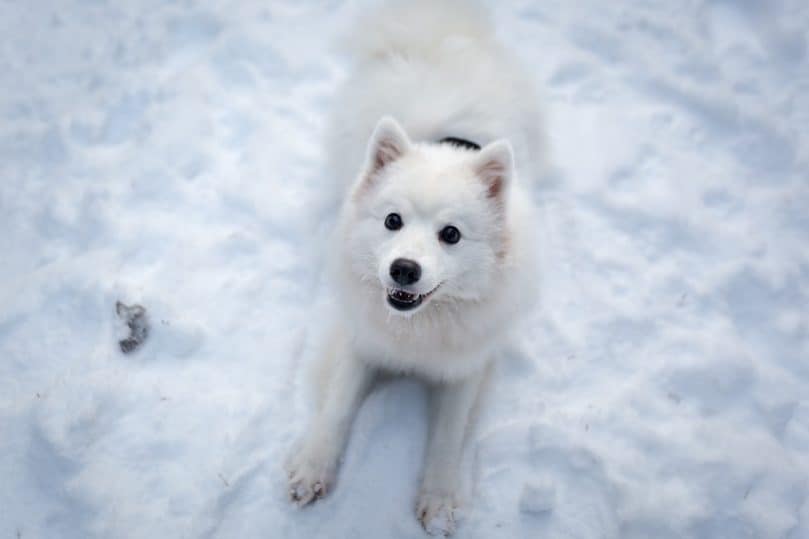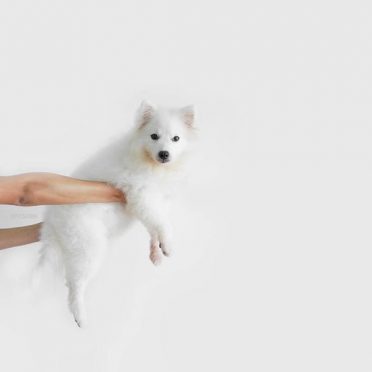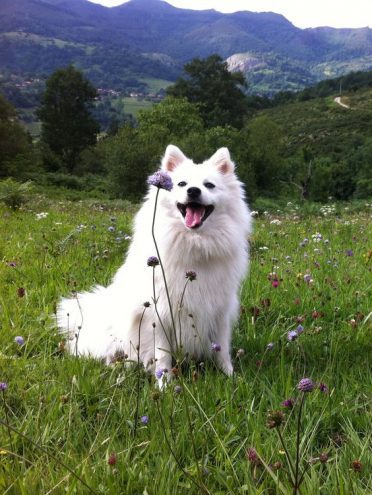This page contains affiliate links. We may earn money or products from the companies mentioned in this post through our independently chosen links, which earn us a commission. Learn More
 The Japanese Spitz is a small to medium dog breed originating from Japan, where it was created by crossbreeding several different Spitz. The Japanese Spitz is around 13 inches tall, weighing anywhere between 11 to 20 pounds. The average lifespan of the Japanese Spitz is about 10 to 16 years.
The Japanese Spitz is a small to medium dog breed originating from Japan, where it was created by crossbreeding several different Spitz. The Japanese Spitz is around 13 inches tall, weighing anywhere between 11 to 20 pounds. The average lifespan of the Japanese Spitz is about 10 to 16 years.
This dog breed is gaining popularity across the world thanks to their reputation as a fantastic pet for any first-time dog owners. Their stunning appearance and ability to be another member of the family makes them the perfect addition to any home.
Don’t let their small size fool you! Find out more about their larger than life personality below.
Contents & Quick Navigation
White, Fluffy, and Oh So Adorable: The Unmistakable Appearance of a Japanese Spitz
You may think you’re looking at a larger than usual White Pomeranian or a smaller version of a Samoyed or an American Eskimo Dog. But we assure you that this breed is unlike any other dog out there, though they are a part of a similar looking grouping of dogs.
The Japanese Spitz is a member of the Spitz dog family. These dogs are all identified by a few distinct traits like:
- triangle shaped ears
- pointed muzzles
- medium to long coats
- fluffy tails that flop over onto their backs
This dog breed is no exception to any of these features, but these little dogs are a particularly adorable member of this group.
The most striking feature is their elegant fur. The long hair around their neck gives them a lion-like appearance. This is appropriate for their boisterous personality! Plus, their black eyes, pads, nails, and nose stand out against the brightness of their white coat.
Dispute on the Exact Size of the Japanese Spitz
Depending on where you are in the world, the size of this pup changes. For instance, the UK standards state they should be 13.5 – 14.5 inches tall. But, the American rules are around 13 inches.
In general, as mentioned above the Japanese Spitz size can be 13 inches (32cm) tall and weigh 11 – 20 pounds (5 – 9 kg). As well, the males tend to be larger than the females. This makes them the perfect size for cuddling on the couch or zooming around the yard during playtime.
The Japanese Spitz Dogs Came From, You Guessed It, Japan

Experts dispute what dog breed the Japanese Spitz originated from. One theory states someone bred them to create a smaller version of the Siberian Samoyed.
Yet, most people believe dog breeders in Japan crossed the White German Spitz with a smaller White Spitz to get the dog breed we know and love today.
Regardless of where they came from, these dogs grew in popularity shortly after appearing for the first time in a dog show in Japan. From there, they traveled from Japan to Sweden, then to England, and finally to the rest of the world.
Most countries accept the Japanese Spitz as an official breed. The outlier in this is the American Kennel Club, who don’t recognize them due to its similarities to the American Eskimo Dog.
One of the Healthiest Purebred Dogs
Great news! The Japanese Spitz is a healthy breed with few genetic problems. That means fewer worries and stress for you and more time enjoying your companion.
But, like most dog breeds, there are a few potential health issues to be vigilant about. The biggest of these threats is Patellar Luxation. This is a condition in which the kneecap dislocates. This can lead to broader problems like lameness and osteoarthritis.
As well, the Japanese Spitz is prone to runny eyes and tear staining. Too small tear ducts, allergies to long grass, and even stress can cause these issues. Be proactive in your dog’s health through annual exams to prevent any concerns from manifesting into more significant problems.
It’s Easy to Keep Your Japanese Spitz Happy and Healthy!
How? Here are just a few tips to ensure your companion continues to be adorable and loveable:
- Make sure to feed your Japanese Spitz a small to medium dog breed formula of food. This way, they’ll receive all the energy they need to maintain their fast metabolism.
- While this dog breed can be suitable for apartment life, make it a part of your to-dos to take your little friend on a daily walk. Strive to include supervised time in a safe area where they can run free without their leash or harness on. This will help encourage them to burn the small dog energy this type of dog possesses.
- These dogs can handle colder climates well. However, they prefer to live in warmer places surrounded by the people they love.
- If you work long hours and don’t expect to be home often, this breed may not be the dog for you. They can grow anxious when left alone for long periods of time. This can lead to destructive behaviors, resulting in more stuff for both you and the dog.
Expect to Have a Companion for Two Decades

We’ve already learned that the Japanese Spitz is a healthy breed. But, on top of that great news, they have a nice and long life expectancy. As mentioned in the first paragraph they can live anywhere from 10 – 16 years long, making them one of the longest-lived dog breeds out there. That’s two decades of fun, love, and memories with your fluffy family member.
Another Member of the Family
The Japanese Spitz makes an excellent companion with their kind, intelligent, and loyal temperament. Because of this, any of these dogs you bring home becomes a part of the family. Not only are they affectionate, but they are also bright and playful.
There’s something to love about this dog breed no matter who you are. They make the perfect playmate for a growing child, a cuddle bug for an elderly couple, and an adventure buddy for an active adult.
Burglars Watch Out!
At first glance, you might think this harmless looking dog wouldn’t attack a fly. You’d be wrong, though. These balls of fluff are also known to be courageous and loyal to their owners, no matter what.
In fact, many proud owners of Japanese Spitzes have claimed their pets make perfect watchdogs. This could be because these dogs bark any time a stranger comes near.
You might be wondering after this factoid if this dog barks a lot. The answer is yes. The Japanese Spitz is a vocal breed. It may look like they have a tiny bark too, but don’t be surprised by the loudness of their voice. We told you they’re great watchdogs!
How Much is a Japanese Spitz?
First, it’s important to know that a Japanese Spitz litter consists of about one to six adorable puppies. One of those pups can cost anywhere from $1,000 to $2,500 depending on which breeder you purchase from.
Before you buy a Japanese Spitz, always do your research beforehand to make sure you’re investing in a reputable breeder. This will ensure your happiness as well as the health of the latest addition to the family!
Can I Adopt a Japanese Spitz?
It’s always possible! However, you might find it challenging to adopt a purebred Japanese Spitz. There aren’t many adoption organizations dedicated to this specific breed.
Keep Their White, Fluffy Coat Gorgeous
You might think those luxurious long coats require lots of extra time and attention when it comes to grooming. But that’s not true! These beautiful coats don’t need all that much extra work.
Bath Time!
For starters, you don’t have to worry about bath time for your Japanese Spitz often. These are for a few reasons.
- Mud and dirt fall off thanks to the non-stick texture of their coat. Whatever stays behind you can brush out.
- Their fur is dry. Because of this, bathe your Japanese Spitz only when necessary. Taking too many can strip them of essential oils from their skin and hair.
Aim to bathe them only a couple times throughout the year.
Yes, Japanese Spitzes Shed A Lot
Japanese Spitz’s thick coats require regular brushing for two reasons.
- Shedding. Regular brushing helps to reduce the number of hairs that will attach to your clothing, furniture, and floors.
- Knots. Consistent brushing helps to prevent knots, tangles, and mats. This is important for a happy and healthy Japanese Spitz!
To make sure you accomplish both of these things, aim to groom them twice a week. Use a pin brush that reaches all the way down to the undercoat.
Viola! You are on your way to a soft and clean coat for your Japanese Spitz.
Dealing with a Molting Japanese Spitz
It’s almost important to note that Japanese Spitz molt. This process occurs for most heavy shedding dogs. Molting happens during the spring while your dog is shedding the heavier winter coat they develop.
To save your clothes, furniture, and floors from a hair attack, you’ll need to step up your grooming schedule. During this time, brush your Japanese Spitz 5-10 minutes daily.
Prepare to vacuum often, even if you do brush your pal using the recommended times above. Japanese Spitzes leave quite a trail of white furs behind in their wake. But does it matter when you get to see that adorable face every day?
To give you an idea of what grooming a Japanese Spitz is really like, watch the video below.
Japanese Spitzes are Intelligent and Eager to Please, so Training is a Breeze!
With that combination, you’ll find in no time at all you’ve taught this dog lots of valuable tricks and behavior habits. Here are a few tips to keep in mind when tackling training your Japanese Spitz!
- Start training early. This ensures your dog learns while they are more susceptible to new commands. It’s true that it’s difficult to teach an older dog new tricks.
- Use consistency in your training. This way, you’ll never confuse your Japanese Spitz on which command you want them to do.
- Patience is key. Take the time to teach this dog a new trick, and they won’t likely forget it.
Don’t Let Your Japanese Spitz Suffer from Small Dog Syndrome
We now know this breed is easy to train! But do you know how important time spent training your dog is?
The Japanese Spitz believes they’re a big dog stuck in a small body. Because of this, if obedience training isn’t provided, their spirited personalities can later grow into a problem.
Why? Training provides your Japanese Spitz with many beneficial things.
The first is a form of entertainment. Dogs like regular stimulation and training is an excellent way to work-out their brains. The more you train, the less your dog will feel bored. Boredom can lead to bad things like destruction and acting out.
Of course, training also helps your dog be more obedient. You want your Japanese Spitz to see you as the leader of the house and to listen to you! The way to do both of those things is training.
Plus, training helps spend energy. All that little dog energy needs to go somewhere if your Japanese Spitz isn’t getting their daily walks or play time. Training is the perfect solution!
Finally, if you train your dog, you’ll be spending more quality time together. Learning tricks is a great way to bond with your Japanese Spitz.
It’s a win-win situation for you and your pooch!
As well, if you have other animals and smaller children, training is especially vital. The more obedient a dog is, the less likely they are to hurt an animal or a child. Make sure to include exposure to other animals and children in your training. This will make those a typical part of your dog’s life, which also leads to fewer dominance-based issues.
To help inspire you in your own training sessions, check out this inspiring video of a Japanese Spitz and her owner nailing many impressive tricks.
Is the Japanese Spitz the Right Dog For Me?
This dog breed makes a fantastic addition to any home. Whether you’re active, elderly, a child, or a first-time dog owner, their loving personality and adorable appearance make them the perfect addition to any family.
Do you love the Japanese Spitz and maybe even own one of your own? Let us know what you think of this breed down in the comments below!




1 reply on “Get to Know the Japanese Spitz: A Devoted & Affectionate Companion”
excellent natured loving dogs
easily trained and kept
I own 2